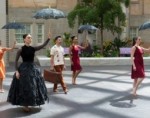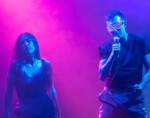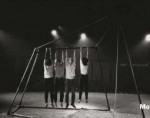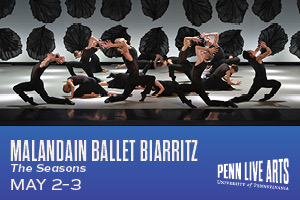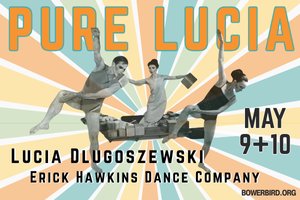
Getting Up to Get Back Down
by Andrew Sargus Klein
Ups and Downs, the brainchild of Baltimore performing duo Peter Redgrave and Khristian Weeks, is on paper a simple retelling of the story of Sisyphus. In practice, the work is a brilliant and subtle immersive experience far unlike most performance you typically find in Baltimore.
The performance also opened Baltimore Independent Dance Artists’ inaugural season. BIDA describes itself as a “volunteer-run, community-based organization created to help sustain, uplift, and increase the visibility of Baltimore-based independent dance.” The organization, founded by my partner, Lynne Price, is an important building block for the city’s independent and DIY performance scene.
Redgrave and Weeks set up at Psychic Readings, a DIY venue in downtown Baltimore, and their performance used all three floors of the space in a sprawling fashion, with the audience deciding when and where to follow. In other words, the venue itself was the mountain, the audience active spectators in the remaking of the classic myth of a king forced to push a boulder up a mountain for all eternity.
The night began in the cramped lobby where we were sold small stones for $2 with the promise that they could be exchanged for a beer later on. A TV broadcasted a live feed of Redgrave and Weeks in matching gray janitorial jumpsuits. They were warming up in a hallway somewhere in the venue, with Redgrave throwing himself atop a gray Pilates ball, over and over. It had a light, absurdist feeling. The audience giggled with each occasional thump, and we realized he was just over our heads, on the second floor.
Once the house opened and the audience was seated, Redgrave positioned himself on the ground with the ball a few feet away, dramatically lit by a low-angle floodlight. An unseen pianist played Erik Satie’s hypnotic “Vexations” (and would do so for the entirety of the performance); a cellist, seated behind the audience, accompanied the piano; and a man, standing next to the cellist, read aloud the very same Wikipedia page I had just read on the car ride over—the backstory to the myth of Sisyphus. Redgrave’s movements were physical, ground-bound sequences. He pushed, nudged, rolled over, attacked, and tenderly held the gray Pilates ball—clearly, his boulder.
Over the course of 15 minutes Redgrave slowly worked himself in and out of contorted balances, where a shoulder or an elbow was all that kept him from falling over. The score easily kept the overall tone tense, expectant, and unresolved. Redgrave’s movements would speed up to an almost frantic pace before re-finding stillness. I felt impatient. We knew the arc of the underlying myth. The question was, what would it look like?
Behind Redgrave an open door framed a utility sink flooded with yellow light. Redgrave slowly progressed toward the door and, with a final comical struggle with his boulder, pushed his way through and out of sight. We heard him again above our heads while we looked at an empty stage. When he popped back into the doorframe, boulder in hand, he surveyed the room, turned around, and disappeared again.
Soon, Weeks appeared at the utility sink, washing dishes. The audience wasn’t sure what to do until a few people walked across the stage and disappeared into the closet. Soon almost everyone followed, until it was just me, my partner, and a third person still seated.
I sat there for another 10 minutes, listening to “Vexations,” the thumps above my head, and the audience’s muffled reactions. Redgrave and Weeks had placed a microphone on the second floor and piped the background noise into the first floor. Clearly the piece invited audience members to follow Redgrave and his boulder throughout the venue space, but this small, powerful choice allowed the performance to exist in multiple places at once, just as with the TV feed in the lobby.
I stayed because I wanted to be one of three people who had the opportunity to see Redgrave reenter the first-floor space—and I knew he would reappear as this was the story of a man endless rolling a boulder up a hill. When he did reappear, it felt like a private performance for a moment. He looked confused, and it was difficult not to impose the underlying myth’s narrative on him, thus re-experiencing Sisyphus as human, as someone completely powerless.
This time I followed Redgrave when he left the first floor again. I found stairs to the left of the utility sink, and up I went. I recognized the second-floor hallway from the lobby TV feed, and made my way to the third floor where I found Redgrave and the rest of the audience. It was as if I walked into another venue. Off to the side of the floor was an enormous, cloud-like structure. Sheet-sized swaths of plastic ballooned with golden air from generators and floodlights hidden somewhere underneath. We were at the top of the mountain, just at the cloud line. It was a sublime moment.
When Redgrave inevitably left, those of us who stayed on the third floor chatted amongst ourselves and unburdened our stones for glasses of beer. I realized Weeks was bussing the glasses down to the first floor to wash in the utility sink, a tweak on the notion of a Sisyphean task.

Photo: Lynne Price
Having the space to sit and experience the performance without directly watching it lent time for contemplation as well as distraction. Ever-present smart phones—those talismans we carry everywhere and will never be able to entirely consume—glowed awake whenever Redgrave disappeared from a given floor. At one point, he reentered the third floor and we saw his boulder was deflated—it was funny, and a little sad. It forced me to consider the relationship between Sisyphus and his boulder and to think of the myth in terms of physical intimacy.
At one point, Weeks secured a chair to Redgrave’s chest with a desk lamp and an unending chain of extension cords. Redgrave awkwardly and quite dangerously made his way back down the stairs. While not outright discordant, it was an odd, kinetic sculptural language to include to the performance, the one odd note in the piece. But it was a good example of Weeks acting as a sort of silent facilitator and manipulator of the performance—the meaning of which is deliciously enigmatic.
If nothing else, Ups and Downs is obsessed with audience experience—in expectation, in movement, in emphasis. A Sisyphean task is endless, and when we’re engaged in such tasks we either tune out completely or the margins of our awareness come into sharp focus. Redgrave and Weeks created something that thrived regardless of where it fell in your field of vision—an enduring, special achievement.
Ups and Downs, Peter Redgrave and Khristian Weeks, Psychic Readings, January 13 - 14.
For the BIDA season schedule, see http://www.bidaseason.com/
By Andrew Sargus Klein
January 27, 2017


